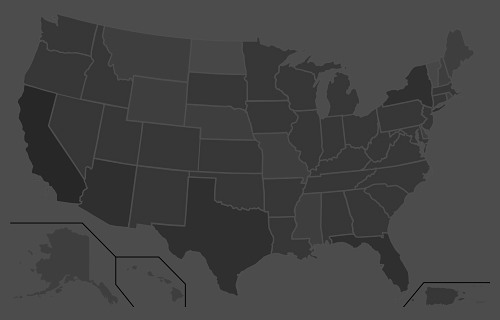“Our added winter moisture and active calling period led to a very long nesting and hatching season, starting in late April and extending into early summer, with chicks hatching as late as early July,” O’Dell said. “From a population standpoint, we are out of a deficit for the first time since 2001-2002. Quail are starting to pop up in places they haven’t been seen in a while.
“If you’ve never had the chance to experience what Arizona quail hunting built its name on, then this would be the year to get out and enjoy it.”
Meanwhile, hunters should note that the season for Mearns’ quail doesn’t begin until Dec. 4. It’s summer rainfall that plays a key role in nesting success and population numbers of this species. After a spotty and relatively weak monsoon across southern Arizona, these birds are likely to be abundant only in pockets that received sufficient precipitation this summer.
A valid Arizona hunting or combination hunt and fish license is required for all hunters 10 and older. Those hunters under 10 must either have a valid hunting or combination hunt and fish license, or be accompanied by an adult who possesses a valid hunting or combination hunt and fish license. Licenses can be purchased online or at license dealers statewide. A youth combination hunt and fish license (ages 10 to 17) is $5.
The general bag limit is 15 quail per day in the aggregate, of which no more than eight may be Mearns’ quail (when the Mearns’ season opens Dec. 4). The general possession limit is 45 quail in the aggregate after opening day, of which no more than 15 Gambel’s, scaled or California quail in the aggregate may be taken in any one day. After the opening of the Mearns’ season, the 45-quail possession limit may include 24 Mearns’ quail, of which no more than eight may be taken in any one day.
More quail-hunting information can be found on the department’s website at https://www.azgfd.com/Hunting/. Another resource for both new and experienced hunters alike is “An Introduction to Hunting Arizona’s Small Game.” Written by Randall D. Babb, the 196-page, full-color book covers where and how to hunt small game birds (like quail), squirrels, rabbits, ducks and geese. It also includes how to prepare and cook your harvest, with illustrations and recipes. The book can be ordered for $16.95 at www.azgfd.gov/publications.
Finally, hunters should check out O’Dell’s techniques for field-dressing quail at https://www.youtube.com/watch?v=3gRwZAcWzzk.
####
Publishers Notes: OUT OF STATE HUNTERS, FISHERMEN & OUTDOOR ENTHUSIASTS; Due to the Covid 19 pandemic, there could be limitations for OUT of STATE hunters, fishermen and other outdoor enthusiasts to include a 14-day quarantine requirement or negative COVID-19 testing alternative. Please check with the State's Department of Natural Resources BEFORE you travel or apply for the 2020 Fall Hunts.
Disclaimer: The views expressed on this site are that of the authors and not necessarily that of TBC Press
Apply for Wyoming 2021 Moose and Bighorn Sheep Permits by March 1st
Submitted by: TBC Press
Posted on: 02/03/21
The Backcountry Press
The country's premier daily HUNTING, FISHING & OUTDOOR news in the USA and around the globe. Read whats happening in your neck of the woods & beyond.
© 2020 TBC Press - All Rights Reserved Website Design by:
News # 14191
Another notable addition for 2021; all applicants will have the ability to make a voluntary donation to Wildlife Crossing, an initiative that funds projects to reduce wildlife and vehicle collisions. Each year, more than 6,000 big game animals are killed on the roads. Read about all the updates in the 2021 Hunting License Application Information.
Details on 2021 deadlines and information is on the Game and Fish Hunt Planner .
MOOSE
Obtaining a moose license can be very difficult or relatively easy depending on the hunt area and the sex of the animal. Cow licenses in many areas can be drawn with only a few preference points, while the drawing odds for a bull or any moose tag are much steeper. Wyoming law allocates 80 percent of moose licenses to residents, with the remaining 20 percent issued to nonresidents. Of course with the random drawing there is always a mathematical chance of drawing a license for first time applicants.
Moose licenses are issued for a hunt area, season dates and sex limitations. The applicant may list only one (1) hunt area choice for moose.
Wyoming statute provides that any successful moose applicant must wait five (5) years to next apply for or receive another moose license. For example, a moose applicant successful in 2011 would not be eligible to apply for or receive another moose license until 2016, nor would the applicant be eligible to purchase a moose preference point during this same five (5) year period (until 2016).
BIGHORN SHEEP
Obtaining a bighorn sheep license is akin to winning the lottery. New applicants with no preference points will at least have a mathematical chance to draw a license if they apply in areas with larger license quotas since 25 percent of the quota in those areas is issued through the random draw. Drawing odds in the random draw are typically less than 1 percent. Once a license is obtained, the successful applicant loses all preference points and must wait five years before applying again.
Hunting bighorn sheep is different from most other big game hunting since most bighorn sheep occupy remote areas within designated wilderness areas. Hunting bighorn sheep is logistically more difficult and physically demanding and typically involves packing gear long distances into rugged country, often at very high elevations. Because of this and Wyoming’s wilderness guide law, nonresidents who draw a bighorn sheep license should anticipate hunting with a guide. Average hunter success is typically around 75 percent. Bighorn sheep must be checked and registered at a regional Game and Fish office or at the Cheyenne office within 15 days of harvest.
####
Publishers Notes: Our country is still battling COVID-19. To avoid the spread of this virus and continue to enjoy outdoor activities, ALL outdoor enthusiasts (man, woman, child) should follow the guidelines set by nps.gov. These guidelines include; social distancing, the Leave No Trace principles, including pack-in and pack-out, to keep outdoor spaces safe and healthy.
Wyoming 2021 hunting applications opened for resident and non-resident Moose and Bighorn Sheep Jan 4th. Deadline to apply is March 1st. All applications must be submitted online.
For 2021 planning, hunters can use the Game and Fish Hunt Planner for estimating season dates. Tentative season information for 2021 is available for moose, sheep, and mountain goat. Elk, deer and antelope hunters can use prior season information for the best estimate. Final season information will be published on May 1, with time for hunters to make modifications or withdraw applications.
New for 2021, nonresident applicants for moose and bighorn sheep will need to elect to opt-in with their applications to be awarded a preference point if unsuccessful in the draw. They will not be automatically purchased if unsuccessful. Otherwise, unsuccessful applicants can apply for a point beginning in July.












